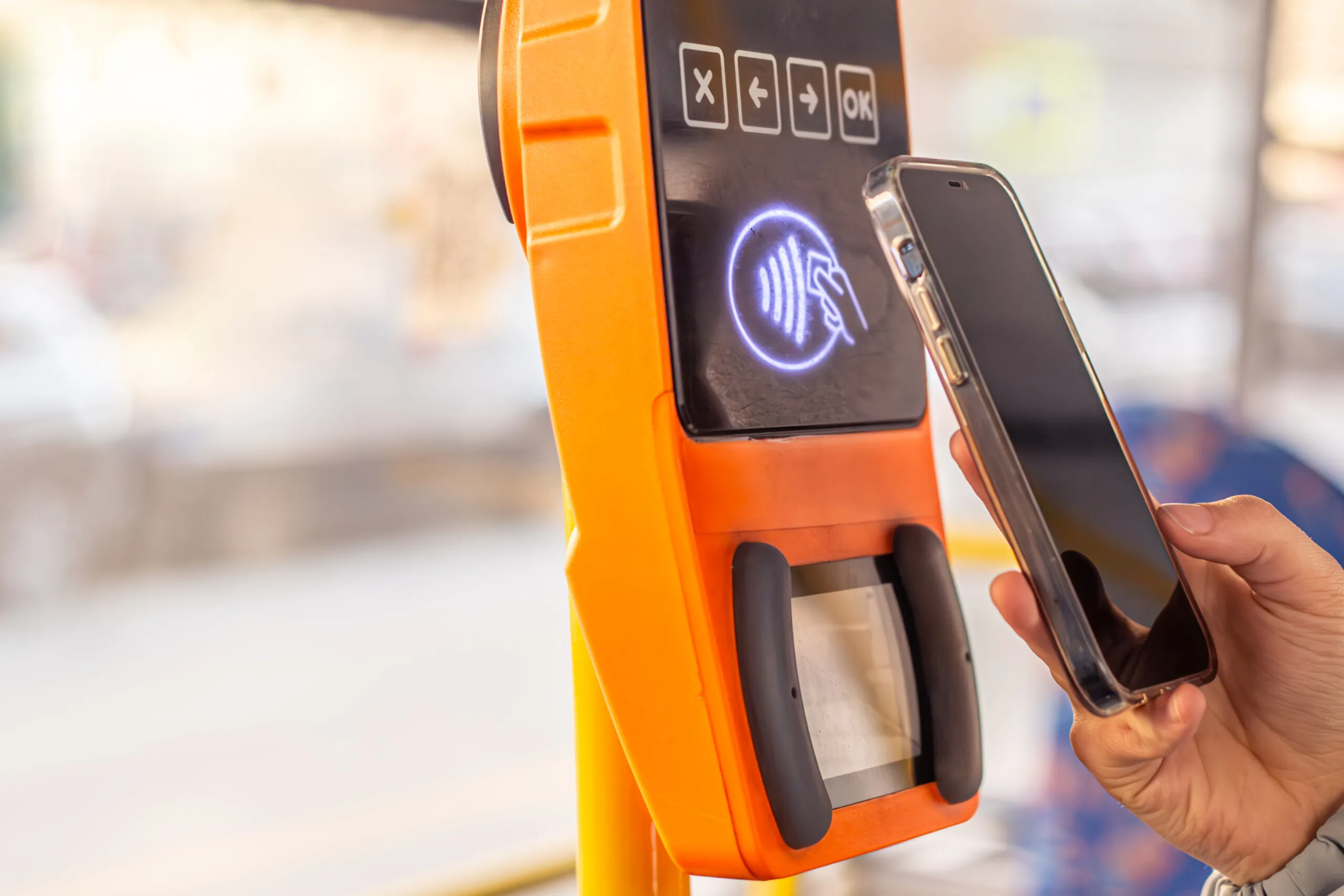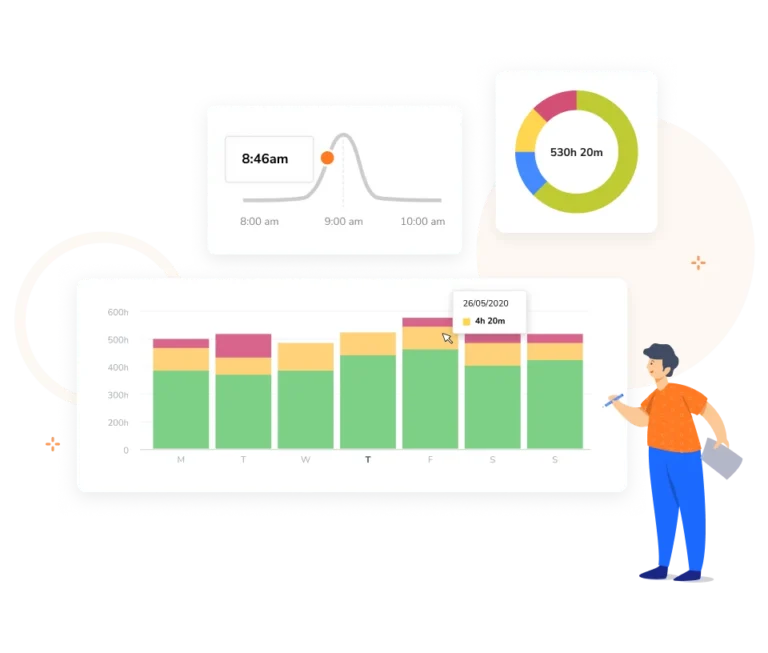How Is NFC Used for Time Tracking?
NFC stands for “Near Field Communication.” It’s a type of technology that allows devices, like smartphones, to communicate with other devices when they’re close to each other, usually within 4 cm.
It enables the sharing of small amounts of data between an NFC tag and an Android-powered device or between two Android-powered devices.
Think of it like magic: when you wave your wand (or phone!) close to another wand, it can send a signal and do things like unlock a door, pay for something, or even track the time you spend on a project.
What Are the Uses of NFC?
NFC is used for lots of things in everyday life! Below are some examples to demonstrate just how common this technology actually is:
- Have you ever seen people using their phones to pay for things? That’s one way NFC is used in everyday life. You can store your credit card information on your phone and then use it to pay for things by tapping your phone on a payment terminal. It’s a super cool way for devices to talk to each other and make things happen.
- Another way NFC is used is for sharing things like photos or music. Have you ever wanted to share a song with a friend but didn’t have a way to do it? With NFC, you can just tap your phone on your friend’s phone, and the song will transfer over. Pretty sweet, right?
- You’re probably familiar with the fact that NFC technology is used for public transport in many cities around the world for contactless ticketing systems, which allow commuters to pay for their fare by tapping their NFC-enabled smartphones or smart cards on readers installed at the entrances and exits of stations or on buses and trains. With NFC-based contactless ticketing, commuters no longer need to carry cash or paper tickets, which makes the process of boarding and exiting public transport faster and more convenient. NFC technology is also used to provide real-time information about public transport schedules, delays, and changes, allowing commuters to plan their journeys more effectively.
- NFC is also used for things like access control. For example, some schools or workplaces use NFC-enabled ID cards to allow people to enter certain areas. All you have to do is tap your ID card on a reader, and the door will unlock for you.
- In the healthcare industry, NFC can be used for tracking patient records and medication administration, as well as for providing patients with access to their medical history and other health-related information.
- NFC can also be used for marketing purposes, where NFC-enabled advertisements or product packaging can be tapped with a smartphone to provide consumers with more information or access to exclusive offers.
You see, NFC is a really cool technology that can make your life easier in a lot of ways. Whether you’re paying for things, sharing music, or entering a restricted area, NFC can help you do it quickly and easily just by tapping your phone on another device.
One of the advantages of NFC over other wireless communication technologies, such as Bluetooth or Wi-Fi, is that it requires very little power to operate, which makes it ideal for devices with limited battery life or for applications where power consumption is a concern.

Photo by pvproductions on Freepik
So, How Exactly Can NFC Be Used for Time Tracking?
NFC technology has revolutionized the way we interact with our devices and the world around us. In today’s fast-paced business environment, efficient time tracking is essential for ensuring productivity, maximizing resources, and maintaining accurate records. NFC technology has become a valuable tool for time tracking in the workplace.
With its ease of use and precision, NFC technology can streamline HR processes, improve payroll accuracy, and provide real-time data insights. Let’s explore some key examples that demonstrate the many advantages of NFC technology for time tracking:
- Employee check-in/out: Employees can use their NFC-enabled ID cards or smartphones to check-in and check-out of their workplace. This method eliminates the need for traditional time cards and reduces the likelihood of errors or time theft.
- Project time tracking: NFC tags can be placed on each project or task, and employees can tap their NFC-enabled devices on the tags to track their time spent on that particular project or task. This method allows for more accurate and precise project time tracking. No more guessing how much time was spent on a project and more precise metrics to ensure productivity.
- Attendance tracking: NFC tags can be placed on classroom doors, meeting rooms, or conference halls, and attendees can tap their NFC-enabled devices on the tags to mark their attendance. This method eliminates the need for paper sign-in sheets and provides real-time attendance tracking.
- Access control: NFC can be used to control access to restricted areas in a workplace. Employees can tap their NFC-enabled devices on a reader to gain access to certain areas, and their access times can be tracked for security purposes.
- Streamlined Processes: NFC can help streamline HR processes, allowing employers to automate time tracking and reduce administrative tasks. This saves time and resources, enabling HR professionals to focus on other critical areas of the business.
- Real-Time Tracking: NFC-enabled devices can provide real-time data, allowing employers to monitor their workforce’s productivity and efficiency in real-time. This enables HR professionals to identify areas of improvement and optimize their workforce’s performance.
- Improved Payroll Accuracy: NFC technology can help ensure payroll accuracy by providing reliable and accurate records of employee working hours. This can reduce the risk of errors and disputes, ensuring that employees are paid accurately and on time.
- Cost-Effective: NFC technology is a cost-effective solution for time tracking, providing a simple and efficient way to monitor employee working hours. This reduces the need for manual tracking and minimizes the potential for errors, saving businesses time and money.
- Remote Access: NFC-enabled devices allow employees to check-in and check-out remotely, providing flexibility and convenience. This is particularly beneficial for businesses with remote or mobile workforces, enabling them to track their working hours regardless of their location.
- Easy Integration: NFC technology is easy to integrate with existing HR systems, making it a seamless and hassle-free solution for businesses looking to upgrade their time tracking processes.
- Increased Transparency: NFC technology provides transparency in time tracking, allowing employers to monitor and verify their employees’ working hours accurately. This promotes trust and fairness, leading to increased employee satisfaction and loyalty.
- Data Analytics: NFC-enabled devices can provide valuable data insights that can help businesses improve their workforce’s productivity and performance. HR professionals can use this data to identify trends, analyze employee behavior, and optimize their workforce’s performance.
It is clear that NFC technology offers businesses a powerful and flexible solution for time tracking.
Learn more about What Is an NFC Attendance Tracker.
What Are Some Key Differences Between NFC and RFID?
If you’re trying to decide between NFC (Near Field Communication) and RFID (Radio Frequency Identification) for time tracking, know that both are popular technologies but with some key differences. Let’s delve deeper into these differences to gain a better understanding of which one may be better suited for your needs.
One of the primary differences between NFC and RFID is their compatibility with smartphones. NFC technology is typically more compatible with smartphones, making it easier for employees to use.
This is because NFC-enabled devices are more commonly found in smartphones, allowing employees to simply tap their device to the reader to clock in and out. This can make it a more convenient option for businesses looking to streamline their time tracking processes.
However, one limitation of NFC is its shorter range compared to RFID. NFC requires that employees be physically close to the reader, typically within a few centimeters, in order to clock in and out. This makes it less suitable for larger workplaces or situations where employees need to clock in from a distance.
On the other hand, RFID technology has a longer range and can be used to track employees or inventory from a greater distance. This can make it more suitable for larger workplaces or for tracking inventory in a warehouse or storage facility. It is to note though, that RFID readers can be more expensive and require more maintenance compared to NFC.
Learn more about What is an RFID Attendance Tracker.
NFC vs. RFID: Which Is the Better Choice?
Overall, the choice between NFC and RFID depends on your specific needs and the nature of your workplace. If you have a smaller workplace and are looking for a more convenient time tracking solution, NFC may be the better option.
If you have a larger workplace or need to track inventory from a greater distance, RFID may be a more suitable option despite its higher cost and maintenance requirements.
It’s important to weigh the pros and cons of each option and consider your specific needs before making a decision. Once you’ve done that, you’ll be able to pick the one that suits you best.
Related Articles:
You Need This in Your Next Time Tracking Software
How to Introduce Time Tracking to Your Team
26 Time Tracking Best Practices
Making Every Moment Count: The Science and Strategy of Time Tracking



